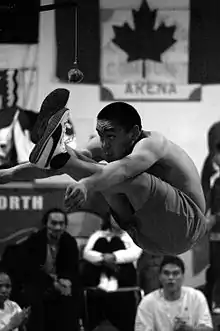High kick
The high kick is a traditional Inuit event performed at the Arctic Winter Games, the World Eskimo Indian Olympics and other traditional events.

One foot high kick
The Inuit one-foot high kick is a traditional competition that is similar to the two foot high kick.
In this competition the competitor stands on one foot, jumps in the air and hits a ball or piece of seal such as a ringed seal, which is suspended from a gallows and then lands on the same foot.
The one foot high kick tests the strength and agility of a hunter. It was also used to signal a successful hunt in some communities.[1]
A short film made by Alethea Arnaquq-Baril for the 2010 Winter Olympics in Vancouver shows Arctic Winter Games champion Johnny Issaluk performing a one foot high kick.[2]
Two foot high kick
The two-foot high kick (akratcheak) is a traditional Inuit jumping event that occurs at many Arctic sports competitions. In the two-foot high kick, athletes must jump using two feet, touch a hanging target with both feet, and land on both feet, maintaining balance.[3] The event is often considered the most demanding Arctic sport.[4]
The event has its origin in subsistence whale hunting: when a whale was taken, a messenger would run to the village and kick both feet in the air once within eyeshot.[3][5] Villagers would then know to prepare to harvest the whale.[3][5]
As of 2007, the men's record in the event was 2.64 m (8 ft 8 in); the women's record was 1.98 m (6 ft 6 in).[5]
Alaskan high kick
Balance on one foot while holding the other. Kick a target straight above with the balancing foot to reach a target, then land on the balancing and kicking foot.[6]
| Wikimedia Commons has media related to Inuit high kick. |
References
- One Foot High Kick
- Hamilton, Mark (2013-04-22), Inuit High Kick, retrieved 2018-09-08
- ""Why These Games"". Archived from the original on 9 January 2007. Retrieved 2008-04-27.CS1 maint: bot: original URL status unknown (link). World Eskimo Indian Olympics. Originally accessed 2008-04-26.
- "Traditional sports descriptions". Yukon Aboriginal Sport Circle (2007). Accessed 2008-04-26.
- Block, Melissa. "Eskimo-Indian Olympics Capture Native Traditions". All Things Considered. National Public Radio (July 23, 2007). Accessed 2008-04-26.
- "Alaskan High Kick". Retrieved June 29, 2018.
External links
- Video of One Foot High Kick on YouTube
- "The Games", ANKN.UAF.edu.
- Video of athlete kicking 7'10" on YouTube